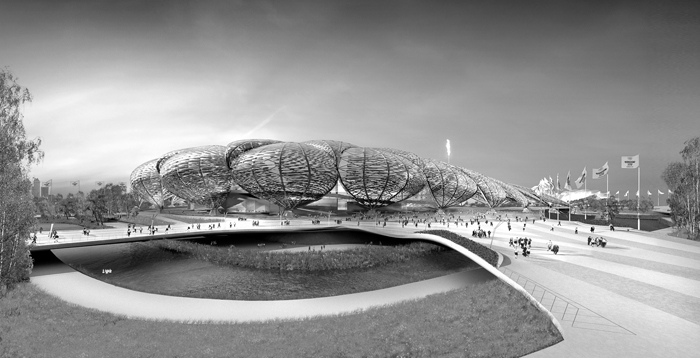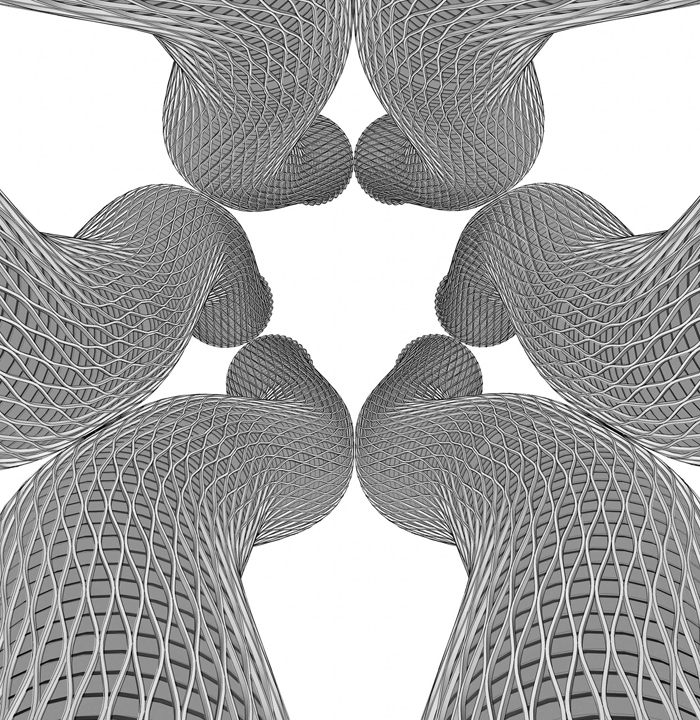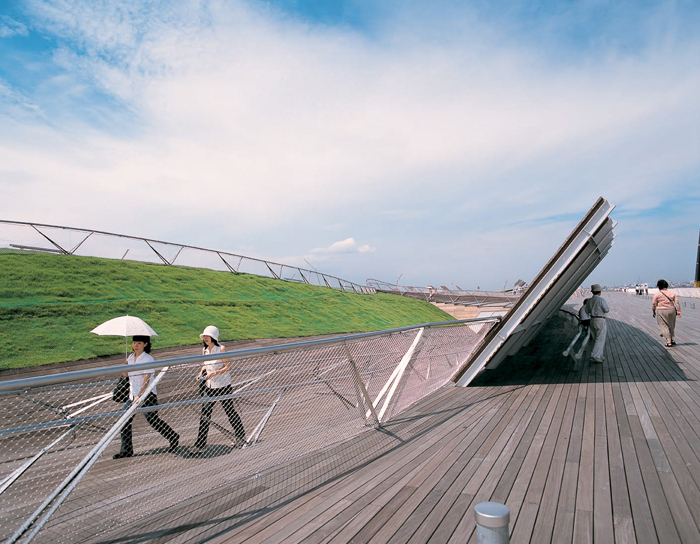
BBC White City Music Centre and Offices with Pierre Boulez projection, Foreign Office Architects: Farshid Moussavi and Alejandro Zaera-Polo with Nerea Calvillo, Kelvin Chu Ka Wing, Kazuhide Doi, Eduardo Fernández-Moscoso, Laura Fernández, Kensuke Kishikawa, Friedrich Ludewig, Kenichi Matsuzawa, Jordi Pagès i Ramón.
Would you feel out-of-place if your city didn’t boast a glistening Gehry building; how about a pristine Richard Meier complex? Even though “signature” architecture seems to be all the rage these days, the young mavericks known as Foreign Office Architects have been making waves by favoring a one-off approach over advancing a recognizable style. They don’t do sketches, nor do they claim to be interested in beauty. Alter- natively, they speak of developing each project in relation to its specific site instead of simply transplanting a finished product. FOA often collects and distills raw contextual data concerning circulation, use, topography, demographics, building and shipping logistics, and other like attractors into various generative models and diagrams.
But being different is no new trend for FOA’s principles; Farshid Moussavi, an Iranian, met Spaniard Zaera-Polo while they were attending the Graduate School of Design at Harvard University. They then worked for Rem Koolhaas before opening shop in London. Playing off their nomadic habitude, FOA tries to embrace foreignness as a kind of architectural instigator, attempting to approach each project with a fresh and sensitively eager eye.

The London 2012 Olympic Park, Foreign Office Architects.
One of the most striking aspects of FOA is their relative youth in a profession that usually finds 50-year olds cutting their teeth on suburban house extensions. By their fortieth birthdays, Moussavi and Zaera-Polo had already completed projects on three continents. The crown jewel is the Yokohama International Port Terminal (1996-2000), a structure that seductively folds the urban city into the sea through a promenade of undulating wooden “dunes” that duck and weave in and out of the building envelope like a fabric landscape. The terminal opened to immense critical and commercial fanfare and catapulted the young architects into the big leagues. Judging from their recent major commissions including the BBC’s Music Theatre in London, and their appointment as architects for the London 2012 Olympics, FOA are quickly becoming the leaders of the new school.
I called the office to request an interview and Moussavi responded cordially; below are some excerpts of my conversation with her.
Adam Kleinman: Instead of starting with a sketch or a building precedent, it is my understanding that you often work via a statistical layering of information such as how the building will be used, possible circulation models, structural ideas based on the technical requirements of site and program, and so forth. These “ingredients” are then feed into computer models and diagrams which “breed” form.

World Trade Center Competition Submission, Foreign Office Architects: Farshid Moussavi and Alejandro Zaera-Polo with Daniel Lopez-Perez, Erhard An-He Kinzelbach. Courtesy of Foreign Office Architects.
Farshid Moussavi: We talk about growing rather than deploying projects. This comes out of an interest in discovering and experimenting rather than producing or perfecting what we know. Connected with this process are of course the tools that you need. We have been working with a diagrammatic approach — diagram as a tool that allows for openness. We refer to the diagram as a material organization that prescribes a performance, but also allows for the project to develop ad infinitum. A diagram doesn’t, at any one time, contain the final formal determination; there needs to be mediation between the diagram and the form of the building. In that sense, there is always a prototypical aspect of a diagram that makes it attractive in the sense that it can apply to other contexts; that one can learn from it. But of course, when it gets deployed, that mediation between the diagram and the form of the building develops in a particular way. It becomes unique to a particular location.
The Yokohama ferry terminal project was an extreme diagrammatic process because of the time it took to realize the project. It was a test of how open a project can be. We began with a small set of decisions then, over seven years, we incorporated decisions of a more contingent nature into the diagram. Typically, these contingencies are digested in such a way so as to create the least amount of resistance to the original set of decisions of a project. Our experiment was to reverse this; there were new sites of opportunities over seven years. Our diagrammatic process allowed us to be flexible to changes brought along by the new material, and evolve the building rather than simply build it.
A diagram prescribes performance so at anyone time you are making a number of decisions. It describes a relationship across a number of parameters, but it is not metric. You can add other parameters to it; you can stretch it. You revisit it constantly and analyze it. You make decisions constantly while allowing for re-evaluation and evolution.

World Trade Center Competition Submission, Foreign Office Architects: Farshid Moussavi and Alejandro Zaera-Polo with Daniel Lopez-Perez, Erhard An-He Kinzelbach. Courtesy of Foreign Office Architects.
Kleinman: I think that this idea of reevaluation and evolution is a theme that carries over to your archival organization as well. In your World Trade Center Proposal, you use titles that sound like Linnean Latin categories from biology class; the towers are classified as Ensifacopa planoripol, an acronym for ENvelope SIngle FAce COnstant PArallel PLANar ORIented POLar. To my understanding, this deals with the lattice system, which you use to both clad and support the towers. In the age of computer- generated architecture, where gratuitous form-making can easily prevail, how does your classification system act as a check to your design process?
Moussavi: One has to keep in mind that this classification happened a posteriori to the design phase. We were invited to do a series of shows; the first one was in Japan and then it expanded for the ICA [Institute of Contemporary Arts] show in London. We wanted the show to look at the work with a “fresh eye,” especially at a time when the work of an architectural office is already so accessible. It was a kind of standing back, a self-analysis of the work of the office over its first ten years. We thought it would be interesting to see if there were in fact strands; to what extent were the projects similar and to what extent where the projects different? We had attempted to start every project by being open to the kind of specifics that were available. However, it was evident that we were developing certain skills that carried across project. The system of classification produced for the show revealed to us that we had not yet explored certain hybrids across the surface typologies; at the right opportunity, we could exploit them.

Yokohama International Port Terminal, Foreign Office Architects: Farshid Moussavi and Alejandro Zaera-Polo with Ivan Ascanio, Yoon King Chong, Michael Cosmas, Jung-Hyun Hwang, Guy Westbrook, 1996-2000. Photograph by Satoru Mishima, courtesy of FOA.
Kleinman: Lets talk a little about “Event Space” or the “space of possibilities” in your projects. On one hand, they are open spaces for public interpolation, but at the same time, they are deliberate attempts at geometric form making. Traditionally, earthworks and other forms of ground manipulation in relation to bodily movement have been used as a form of militaristic crowd control. Yet you use topology in an opened ended manner so that undulating surfaces are utilized to spur corporal responses in the user as s/he quite literally accesses the terrain, for example a skateboarder looking for a certain kind of handrail. How have you channeled this phenomenological act of determinism into a kind of sharing gesture, in which surface informs a successful public site?

Yokohama International Port Terminal, Foreign Office Architects: Farshid Moussavi and Alejandro Zaera-Polo with Ivan Ascanio, Yoon King Chong, Michael Cosmas, Jung-Hyun Hwang, Guy Westbrook, 1996-2000. Photograph by Satoru Mishima, courtesy of FOA.
Moussavi: First of all, I don’t feel that there is anything wrong with learning from the military.
The interests that have existed in “Event Space” have mainly been about how to program unexpected behavior into space, to allow for other things, other uses of space that are not in the functional brief. Our experience with the issue has emerged out of being involved in a number of projects requiring the design of open public space, a new kind of architecture that is an intermediary in scale between a building and a fabric. The experiments we have performed explore the coincidence of a number of the systems involved in the project to trigger new possibilities within the space. In the Yokohama project for example, a set of seemingly dysfunctional spaces are generated as a result of the coincidence of the structure and the circulation ramps that do not have conventional headroom, and become seating or resting places in excess to the brief; handrails that diminish in height become sites for skateboarders, etc. The physical structure has finally incorporated a sense of order that, in a way, generates another set of possibilities. The cases at these moments and junctures encourage other ways of using space.
Adam Kleinman is an Associate Curator at the Lower Manhattan Cultural Council.
